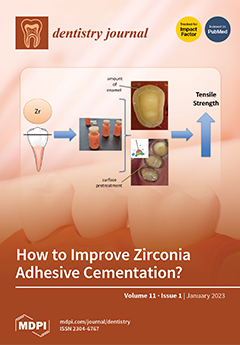Associations of
CRISPLD2 (cysteine-rich secretory protein LCCL domain containing 2) and genes belonging to its activation pathway, including
FOS (Fos proto-oncogene),
CASP8 (caspase 8) and
MMP2 (matrix metalloproteinase 2), with nonsyndromic orofacial cleft risk, have been reported, but the results are yet unclear. The aim of this study was to evaluate single nucleotide polymorphisms (SNPs) in
FOS,
CASP8 and
MMP2 and to determine their SNP-SNP interactions with
CRISPLD2 variants in the risk of nonsyndromic cleft lip with or without cleft palate (NSCL±P) in the Brazilian population. The SNPs rs1046117 (
FOS), rs3769825 (
CASP8) and rs243836 (
MMP2) were genotyped using TaqMan allelic discrimination assays in a case-control sample containing 801 NSCL±P patients (233 nonsyndromic cleft lip only (NSCLO) and 568 nonsyndromic cleft lip and palate (NSCLP)) and 881 healthy controls via logistic regression analysis adjusted for the effects of sex and genomic ancestry proportions with a multiple comparison
p value set at ≤0.01. SNP-SNP interactions with rs1546124, rs8061351, rs2326398 and rs4783099 in
CRISPLD2 were performed with the model-based multifactor dimensionality reduction test complemented with a 1000 permutation-based strategy. Although the association between
FOS rs1046117 and risk of NSCL±P reached only nominal
p values, NSCLO risk was significantly higher in carriers of the
FOS rs1046117 C allele (OR: 1.28, 95% CI: 1.10–1.64,
p = 0.004), TC heterozygous genotype (OR: 1.59, 95% CI: 1.16–2.18,
p = 0.003), and in the dominant model (OR: 1.50, 95% CI: 1.10–2.02,
p = 0.007). Individually, no significant associations between cleft risk and the SNPs in
CASP8 and
MMP2 were observed. SNP-SNP interactions involving
CRISPLD2 variants and rs1046117 (
FOS), rs3769825 (
CASP8) and rs243836 (
MMP2) yielded several significant
p values, mostly driven by
FOS rs1046117 and
CASP8 rs3769825 in NSCL±P,
FOS rs1046117 in NSCLO and
CRISPLD2 rs8061351 in NSCLP. Our study is the first in the Brazilian population to reveal the association of
FOS rs1046117 with NSCLO risk, and to support that
CRISPLD2,
CASP8,
FOS and
MMP2 interactions may be related to the pathogenesis of this common craniofacial malformation.
Full article






